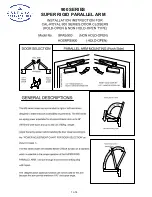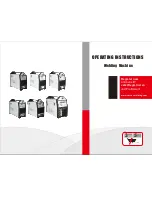
106
3.3
gas selection
The PT-26 is a dual gas torch, allowing for one gas to be used for plasma gas and another to be used for shielding
the cut zone. Recommended combinations of gases are listed below.
air plasma/air shield
Best overall combination for cut quality, cut speed and economy on mild steel, stainless steel and aluminum.
This combination causes some surface nitrating at cut face and some surface oxidation of alloying elements on
stainless steels. Always use clean, dry air. Moisture or oil in the air supply will reduce torch parts life.
Nitrogen plasma/air shield
This combination provides improved parts life, especially for the electrode. Cut speeds will usually be slightly
slower than with air plasma. It creates surface nitriding but provides cleaner cut face on stainless steels. Nitrogen
or CO
2
may be substituted for cooling.
h-35 plasma/Nitrogen shield
This combination gives excellent parts life with minimum amount of cut surface contamination, providing ex-
cellent weldability. It is most often used for gouging on mild steel, aluminum, and stainless steel. It gives poor
cut quality on mild steel, good cut quality on aluminum and stainless, particularly on thicker sizes.
40% hydrogen - 60% Nitrogen plasma/air shield
On aluminum only, gives increased speed and thickness capability. Poor performance on stainless and mild
steel.
oxygen plasma/air shield
Best quality for mechanized cutting of mild steel 1” (25.4 mm) thick or thinner with 150 to 300 amps. Highest
metal removal rate for gouging on mild steel.
3.4
gas connections
Refer to Section 3.3 for the list of approved service gases. Do not use gases which are not expressly approved
for the PT-26 torch.
After the gases for the job have been selected, connect the gas supply hoses to the fittings at the back of the
power source. Note that there may be two fittings for each gas. Use the fitting which matches your hose. Make
sure that the fittings not used are plugged with the plug attached to the power source.
Note that the ESP-150 & ESP-200 power source has a gas connection labeled “Start Gas”. This allows a differ-
ent plasma gas type and pressure setting to be used for the plasma gas at the start of the cut. This is done to
increase electrode life during some types of mechanized plasma cutting. The start gas most typically used in
manual cutting is either the same gas as that used for the cutting/gouging plasma or nitrogen.
IMportaNt! a gas supply Must be supplied to the “start gas” connection at all times. If this is not
done, the torch will be damaged. the start gas may be any of the approved plasma gases listed in section
above.
sEctIoN 3
INstallatIoN
usE oNlY thosE gasEs lIstED as approvED IN thIs DocuMENt.
WarNINg
Summary of Contents for PT-26
Page 2: ... ...
Page 4: ... table of contents ...
Page 5: ...PT 26 Hořák pro plazmové řezání Uživatelská příručka CS 0558003747 ...
Page 8: ... obsah ...
Page 35: ...PT 26 Plasmabue skærebrænder 0558003747 Instruktionsbog DA ...
Page 38: ...38 Indholdsfortegnelse ...
Page 65: ...PT 26 Toorts voor plasmasnijden Instructiehandleiding NL 0558003747 ...
Page 68: ...68 inhoudsopgave ...
Page 95: ...PT 26 Plasma Arc Cutting Torch Instruction Manual EN 0558003747 ...
Page 98: ...98 table of contents ...
Page 125: ...PT 26 Plasmakaarkeevituspõleti Kasutusjuhend ET 0558003747 ...
Page 128: ...128 sisukord ...
Page 155: ...PT 26 Plasmakaarileikkauspoltin Käyttöohje FI 0558003747 ...
Page 158: ...158 Sisällysluettelo ...
Page 185: ...PT 26 Torche de découpage au plasma Manuel d instructions FR 0558003747 ...
Page 188: ...188 Table des matières ...
Page 215: ...PT 26 Plasmaschneidbrenner Betriebsanleitung DE 0558003747 ...
Page 218: ...218 Inhaltsverzeichnis ...
Page 245: ...PT 26 Plazmaíves vágópisztoly Használati útmutató HU 0558003747 ...
Page 248: ...248 tartalomjegyzék ...
Page 275: ...PT 26 Torcia per il taglio con arco al plasma Manuale di istruzioni IT 0558003747 ...
Page 278: ...278 INDICE ...
Page 305: ...305 notes ...
Page 306: ...306 notes ...
















































